|
|
|
Sort Order |
|
|
|
Items / Page
|
|
|
|
|
|
|
| Srl | Item |
| 1 |
ID:
168190
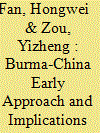

|
|
|
|
|
| Summary/Abstract |
During the Cold War Burma followed a foreign policy of neutralism that was shaped between 1948 and 1954. In 1954, Burma began to move closer to China in order to balance the Western influence in the country. The diplomatic balancing skills of Burmese leaders were reflected in Burma's early postcolonial diplomacy and constitute a substantial core dimension of the Burmese foreign policy tradition. Between 1998 and 2010 Burma was heavily reliant on China in the face of Western sanctions and its relative isolation; China's influence thus increased sharply in that country. The pattern of China-Burma-US triangular relations that was restructured in the early 1950s reappeared in the twenty-first century. Beginning in 2011, Nay Pyi Taw's policy reflected a determination to weaken China's growing influence and rebalance Burmese relations with Washington and Beijing. However, this Burmese rebalancing was overinterpreted by the media as Nay Pyi Taw's shift into the American orbit. Both Thein Sein and Aung San Suu Kyi have attempted to steer Burma's foreign policy back to its traditional neutralist and nonaligned track.
|
|
|
|
|
|
|
|
|
|
|
|
|
|
|
|
| 2 |
ID:
168193
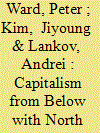

|
|
|
|
|
| Summary/Abstract |
Post-socialist transformation has been studied extensively in Eastern Europe, the former Soviet Union, and other states in Asia. This article will examine the North Korean experience and suggests how North Korea's post-socialist experience can be positioned within the broader picture of post-socialism. In this article we focus on the following three areas: the state sector, capitalist class formation and capital accumulation, and the role of foreign investment. We rely on a reading of North Korean laws and North Korean official publications, previous survey work involving firms dealing with North Korea in the past and present, as well as official North Korean census data to offer as full a picture as is possible.
|
|
|
|
|
|
|
|
|
|
|
|
|
|
|
|
| 3 |
ID:
168189
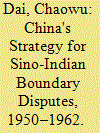

|
|
|
|
|
| Summary/Abstract |
Between the establishment of the People's Republic of China (PRC) and the outbreak of the Sino-Indian Border War in 1962, there were three distinct stages in Beijing's approaches to border issues with India. A "temporary maintenance of the status quo" marks the first stage, from 1951 to 1954. In the second stage, from 1955 to April 1960, China prepared for a negotiated settlement and proposed an East-West swap solution, with China's recognition of the McMahon Line as a prerequisite. In the third stage, from May 1960 to October 1962, judging that India was unwilling to negotiate a solution, China made preparations for deployment of its military and adopted a policy of "never yield while striving to avoid bloodshed, create interlocking positions for long-term armed coexistence" on the border issue, ultimately proceeding to the border conflict. This research analyzes the roles that domestic politics, Chinese leaders' perspectives, and dynamics related to the Cold War have played in China's strategies toward its border tensions with India. More importantly, based upon research in declassified archives, this article identifies the major issues of the Sino-Indian border dispute and hence attempts to provide a framework for China and India to build a mutually acceptable approach to future discussions as well as for formulating a resolution to the boundary issue.
|
|
|
|
|
|
|
|
|
|
|
|
|
|
|
|
| 4 |
ID:
168191


|
|
|
|
|
| Summary/Abstract |
Since Sri Lanka and the People's Republic of China established diplomatic relations in the 1950s, China has become an important partner of Sri Lanka in the latter's cause of maintaining national independence and development. Meanwhile, Sri Lanka has been an important political and diplomatic partner for China in the Third World. Since Chinese president Xi Jinping proposed the Belt and Road Initiative (BRI) in 2013, Sri Lanka has become a new investment hot spot due to its location as a hub of the proposed 21st-Centrury Maritime Silk Road. This article provides views identifying the opportunities and potential challenges for Sino–Sri Lankan relations under the framework of China's 21st-Century Maritime Silk Road initiative.
|
|
|
|
|
|
|
|
|
|
|
|
|
|
|
|
| 5 |
ID:
168195


|
|
|
| 6 |
ID:
168192
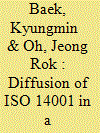

|
|
|
|
|
| Summary/Abstract |
ISO 14001, the most common voluntary environmental program in the world, has in recent years been diffused worldwide. However, the level of this diffusion varies across geographical regions. This article analyzes the case of Korea to illustrate how national institutional environments in the East Asia and Pacific region led to the rapid diffusion of ISO 14001. We hypothesize that developmental states have a highly favorable national institutional arrangement for the deployment of ISO 14001. This study finds that developmental states where governments implement strong initiatives for national development and economic growth, exemplified by Korea, are active in implementing neoliberal practices such as ISO 14001.
|
|
|
|
|
|
|
|
|
|
|
|
|
|
|
|
| 7 |
ID:
168188
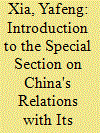

|
|
|
|
|
| Summary/Abstract |
This edition of Asian Perspective features a special section on China's relations with its neighbors, following a full special issue on the topic (Asian Perspective, vol. 42, no. 4, 2018). This special section comprises three articles that offer a historical lens on China's contemporary relations with India, Burma, and Sri Lanka, respectively. Making use of archival documentation from the Chinese Foreign Ministry archives and the Jawaharlal Nehru Memorial Museum and Library, Chaowu Dai explores the evolution of China's policy toward Sino-Indian border disputes. Dai argues that the People's Republic of China (PRC) attempted to peacefully resolve its border disputes with neighboring countries through negotiations. According to Dai, the PRC adopted this approach in resolving its border disputes with Burma, Nepal, and Pakistan prior to the Sino-Indian border clashes in 1959. He thus challenges the view of Indian and Western scholars that China was pursuing territorial expansion.
|
|
|
|
|
|
|
|
|
|
|
|
|
|
|
|
| 8 |
ID:
168194


|
|
|
|
|
| Summary/Abstract |
This article investigates whether countries in East Asia are acting anomalously from traditional balancing and bandwagoning assumptions in the face of China's reemergencel the form of sending ambiguous alignment signals toward the United States in return for more autonomy by states that have no official alliance with Beijing. Incorporating Lim and Cooper's redefinition of hedging, this study focuses on the conditions under which China's neighbors adopt hedging behaviors. This article aims to show that coercive capability indicators, including national capability and a US military presence, are major factors in decisions by countries in East Asia to adopt hedging strategies. The findings suggest that when countries in this region seek to maximize economic benefits with Beijing, they also seek certain security assurances from Washington as a hedge against Beijing's influence over their national affairs.
|
|
|
|
|
|
|
|
|
|
|
|
|
|
|
|
|
|
|
|
|